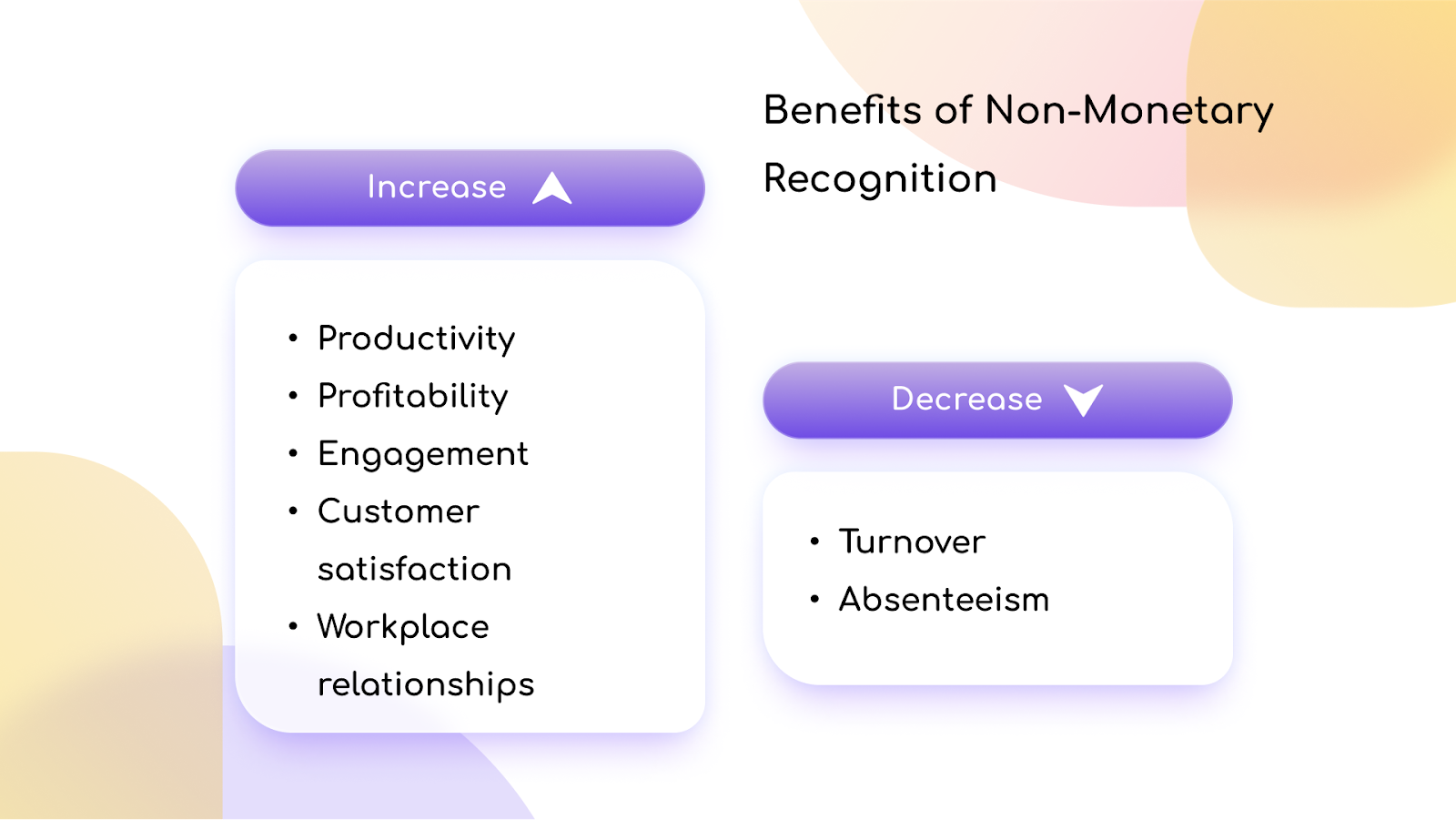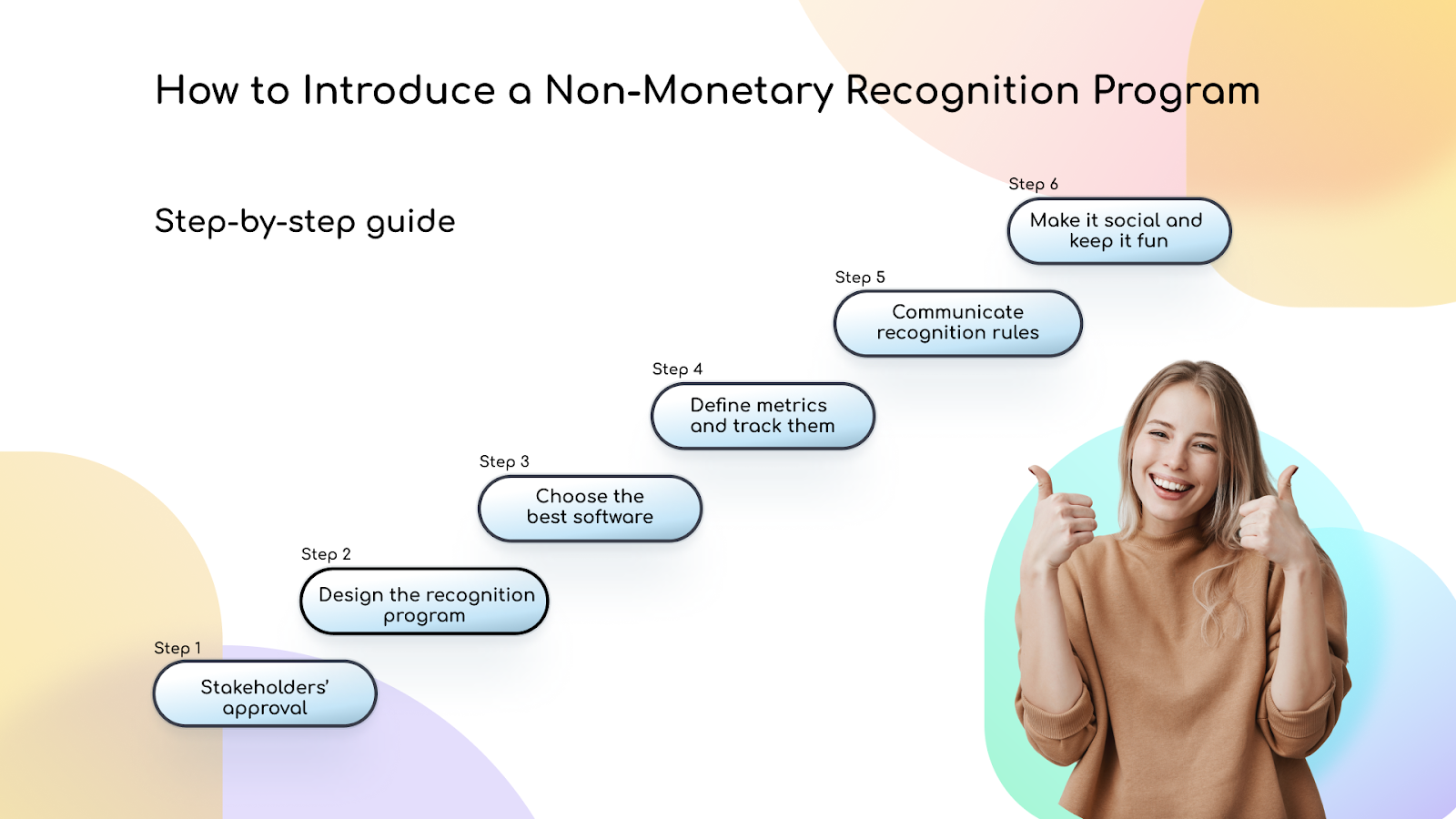8 avantages de la reconnaissance non monétaire sur le lieu de travail
La reconnaissance non monétaire présente de nombreux avantages que les entreprises utilisent pour améliorer l'expérience de leurs employés. Voici 8 avantages de la reconnaissance non monétaire sur le lieu de travail.
Sur cette page
Une stratégie de reconnaissance bien définie peut permettre de réaliser bon nombre des objectifs de l'entreprise. La clé pour créer une culture de soutien et d'appréciation est de lier les valeurs de l'entreprise à la reconnaissance non monétaire. Lisez la suite pour savoir pourquoi et comment.
Qu'est-ce que la reconnaissance non monétaire ?
La reconnaissance non monétaire sur le lieu de travail permet de reconnaître la valeur d'un employé et ses efforts pour contribuer aux objectifs de l'entreprise. La reconnaissance non monétaire n'utilise pas de stimulus monétaire - elle repose sur des messages d'appréciation verbaux ou écrits adressés aux employés.
Les entreprises utilisent la reconnaissance non monétaire pour motiver leurs employés et leur montrer que leur contribution est perçue et appréciée. Ce type de reconnaissance peut être verbal ou écrit, public (social) ou privé, formel ou informel, de pair à pair ou de haut en bas.
Lorsque les entreprises apprécient leurs employés, elles créent une culture d'appréciation et un environnement de travail positif orienté vers la croissance, le soutien mutuel et le respect.
Quelle est la différence entre la reconnaissance et les récompenses ?
La reconnaissance a un objectif commun avec les récompenses, à savoir qu'elle est utilisée pour motiver les employés. Toutefois, il existe des différences marquées entre ces deux moyens de motiver les employés. De la même manière que les récompenses, la reconnaissance a un impact sur le moral et stimule la productivité sur le lieu de travail tout en encourageant les employés à s'efforcer de donner le meilleur d'eux-mêmes.
La reconnaissance non monétaire est intangible et non transactionnelle. Un message d'appréciation écrit ou oral a un poids considérable, même s'il n'a pas de valeur monétaire concrète. En revanche, les récompenses sont tangibles, qu'il s'agisse de récompenses expérientielles, de cartes-cadeaux ou d'articles promotionnels.
En outre, la reconnaissance joue sur la motivation intrinsèque des employés, qui est leur besoin d'être vus et valorisés pour leur excellent travail. Au contraire, les récompenses jouent sur la motivation extrinsèque des employés, leur désir d'obtenir des récompenses spécifiques et d'atteindre un certain statut.
Avantages de la reconnaissance non monétaire
La reconnaissance non monétaire influence la culture d'entreprise, apportant une pléthore d'avantages interconnectés aux entreprises qui s'y prennent bien. Les spécialistes des RH sont d'accord ; selon Hero et Mercer, 85 % des responsables des RH affirment qu'un programme de reconnaissance des employés a un effet positif sur la culture organisationnelle. Voici une liste de quelques-unes des mesures les plus frappantes qui s'améliorent considérablement avec l'introduction de programmes de reconnaissance.

1. Amélioration de la rétention
La reconnaissance non monétaire améliore la fidélisation des employés. Selon la SHRM, 68 % des professionnels des ressources humaines affirment que les programmes de reconnaissance des employés ont un effet positif sur la fidélisation du personnel.
La raison en est que le fait de faire sentir aux employés qu'ils sont appréciés influence leur désir de rester ou non dans une entreprise. L'une des façons concrètes de reconnaître les employés est de célébrer leurs anniversaires de service. Si les entreprises le font suffisamment tôt dans la carrière des employés, elles augmentent les chances qu'ils restent là où ils se sentent appréciés pour leurs efforts.
2. Un engagement accru
La reconnaissance non monétaire a un impact sur l'engagement au travail en soulignant le comportement des employés que les entreprises souhaitent voir plus souvent. Deloitte constate que la productivité, le rendement et l'engagement des employés sont 14 % plus élevés dans les organisations dotées de programmes de reconnaissance que dans celles qui n'en ont pas.
La clé de la réussite d'un programme de reconnaissance non monétaire est de lier les objectifs de reconnaissance aux valeurs de l'entreprise. Par exemple, si une entreprise souhaite améliorer l'expérience client au travail, le programme de reconnaissance doit comporter une valeur qui cible les comportements des employés qui ont de bons résultats avec les clients. Très vite, les employés apprennent quel comportement les fait remarquer.
Plus les employés apprennent que leurs efforts ne passent pas inaperçus, plus ils se sentent encouragés à agir de la même manière. Par conséquent, l'engagement augmente et les employés adoptent régulièrement un comportement conforme aux valeurs de l'entreprise.
3. Augmentation de la productivité et des performances
Tout comme les programmes de non-reconnaissance ont un impact sur l'engagement, ils ont également une influence positive sur la productivité. Si l'engagement en soi est crucial pour une culture d'entreprise positive, il est également essentiel que les employés contribuent aux objectifs de l'entreprise et atteignent les cibles que leurs managers leur ont fixées.
Les employés engagés sont plus productifs. Selon l'Université de Caroline du Sud, la probabilité d'aider ses pairs dans les groupes dotés d'un système de reconnaissance entre pairs établi est de 49,2 %, et dans les groupes sans : 35.9%. Cela signifie que les équipes seront en mesure d'atteindre plus rapidement leurs objectifs si elles sont encouragées à reconnaître les efforts des autres.
4. Amélioration de l'expérience des employés
Lorsque les entreprises font l'effort d'en faire plus pour leurs employés au-delà de la rémunération standard et de la rémunération globale, cela améliore le sentiment des employés de travailler pour un employeur particulier.
Les programmes de reconnaissance non monétaires sont le signe d'une culture d'entreprise positive et prouvent que les employeurs se soucient de leurs employés et les respectent. Lorsque les programmes de reconnaissance sont raisonnables, transparents et équitables, ils renforcent la confiance des employés dans l'employeur, ce qui rend leur présence dans l'entreprise plus significative et plus utile.
5. Amélioration de la satisfaction des clients
Un excellent service à la clientèle consiste à se surpasser. Nous savons depuis longtemps que l'amélioration de l'expérience du client avec une marque contribue au succès de l'organisation.
Comme les entreprises dépendent de leur personnel pour atteindre leurs objectifs, lorsque les employés se sentent satisfaits, cela se répercute également sur les clients. Par conséquent, la satisfaction des clients est étroitement liée à la façon dont les employés se sentent dans une entreprise, et l'expérience des employés est la nouvelle expérience des clients. Des employés satisfaits et engagés feront tout leur possible pour assurer des interactions agréables avec les clients et seront plus résistants pour relever les défis.
6. Une meilleure rentabilité
Une meilleure rentabilité est le résultat de plusieurs avantages combinés : l'amélioration de la productivité permet d'atteindre plus rapidement les objectifs de l'entreprise, la réduction de la rétention permet d'économiser du temps et de l'argent sur l'intégration de nouveaux candidats, l'amélioration de l'expérience des employés attire de nouveaux talents dans l'entreprise et, enfin, la satisfaction des clients fait que les clients existants restent fidèles à la marque. Ces avantages permettent aux entreprises d'économiser de l'argent et d'être plus agiles lorsque des défis se présentent.
Les entreprises peuvent choisir de distribuer des primes et des incitations, ce qui permet souvent de servir les résultats de l'entreprise. Cependant, la reconnaissance non monétaire permet d'inciter les employés à vouloir améliorer les performances de l'entreprise, simplement parce qu'ils aiment en faire profiter l'entreprise, au lieu de se contenter de faire leur travail pour être rémunérés.
7. De meilleures relations sur le lieu de travail
Les gens s'épanouissent dans des environnements qui les soutiennent. La plupart des gens préfèrent travailler dans un environnement où les collègues s'entraident plutôt que de leur faire concurrence. C'est pourquoi la reconnaissance non monétaire a un effet puissant sur les relations au sein de l'entreprise.
La reconnaissance entre pairs, en particulier, joue un rôle prépondérant dans la promotion de relations saines et solidaires sur le lieu de travail. Le fait d'accroître la pratique consistant à voir le bien chez l'autre profite à l'équipe et fait en sorte que chaque personne qui contribue se sente digne d'éloges.
La reconnaissance descendante a également un impact significatif sur les niveaux de confiance entre les employés et leurs managers. Selon Forbes, "près de 90 % des employés qui ont reçu de la reconnaissance ou des remerciements de la part de leur patron au cours du dernier mois ont indiqué avoir davantage confiance en ce dernier." Lorsque les employés se font confiance et font confiance à leurs dirigeants, ils sont vraiment prêts à réussir.
8. Amélioration de l'agilité
Les employés reconnus et satisfaits sont plus motivés pour bien faire leur travail. Les organisations qui valorisent le travail d'équipe, que la reconnaissance non monétaire peut également soutenir, constateront une meilleure synergie dans l'accomplissement des tâches et une plus grande vigilance pour résoudre les problèmes lorsqu'ils se présentent. Seule une main-d'œuvre satisfaite et collaborative aura la résilience nécessaire pour relever les défis lorsque les choses se corsent.
Les programmes de reconnaissance peuvent améliorer l'agilité organisationnelle lorsque la reconnaissance est liée aux valeurs de l'entreprise, comme l'innovation. Les employés qui s'efforcent de fournir constamment des solutions novatrices peuvent trouver de nouveaux moyens qui permettent aux entreprises de pivoter lorsque le marché change.
Comment introduire un programme de reconnaissance non monétaire sur le lieu de travail ?

Dans les paragraphes précédents, nous avons démontré comment les programmes de reconnaissance non monétaires sont très bénéfiques pour le succès des entreprises. Cependant, l'introduction d'un programme de reconnaissance doit se faire étape par étape afin de maximiser les avantages pour l'entreprise. Lisez la suite pour découvrir les étapes cruciales de l'introduction d'un programme de reconnaissance non monétaire.
1. Approbation des parties prenantes
Au niveau organisationnel, les parties prenantes des programmes de reconnaissance sont réparties dans toute l'entreprise. Tout d'abord, il y a les employés qui sont les bénéficiaires et les utilisateurs finaux des programmes de reconnaissance.
En outre, les managers sont les porteurs de la culture d'entreprise et jouent donc un rôle déterminant dans l'adoption d'un programme de reconnaissance non monétaire.
Le département des ressources humaines est la partie prenante la plus importante, car ce sont eux qui détecteront le besoin de programmes de reconnaissance et la manière la plus appropriée de les introduire. Ce sont également les RH qui se chargeront de l'introduction du programme et qui joueront un rôle déterminant dans sa conception.
Enfin, la haute direction doit également être à bord et comprendre les avantages d'un programme de reconnaissance non monétaire entre pairs. De nos jours, les responsables des ressources humaines ont tendance à prendre de l'importance et à occuper une place dans la hiérarchie, et il est devenu plus facile de convaincre les dirigeants de l'importance de mettre en place des programmes de reconnaissance.
2. Concevoir les programmes de reconnaissance
Lorsque des programmes de reconnaissance sont conçus à partir de zéro, la première pièce du puzzle, et la plus importante, est de relier les programmes de reconnaissance aux valeurs de l'entreprise afin de s'assurer que les entreprises créent une culture florissante qui s'aligne sur la mission, la vision et les objectifs de l'entreprise.
La plupart des entreprises choisissent d'utiliser plusieurs programmes de reconnaissance, y compris des programmes non monétaires et monétaires, avec des programmes de pair à pair en plus des options de nomination. Chaque programme doit être conçu avec précision afin de garantir qu'il offre une excellente expérience aux employés et qu'il est lié aux objectifs spécifiques de l'entreprise pour s'assurer qu'il inspire les résultats positifs souhaités.
Il est important de mentionner que chaque entreprise est unique et a des besoins différents en matière de programme de reconnaissance et que ces besoins peuvent changer au fur et à mesure que les entreprises se développent et que les exigences du marché évoluent également. Par conséquent, la flexibilité du programme de reconnaissance est un facteur essentiel à considérer.
3. Choisir le meilleur logiciel de reconnaissance
L'espace technologique des RH regorge d'outils parmi lesquels choisir, mais tous les outils ne sont pas conçus de la même manière. Certaines petites et moyennes entreprises ont des besoins différents et bénéficient d'autres outils que les entreprises.
Certains programmes de reconnaissance, par exemple, ne fournissent qu'une plateforme de reconnaissance, avec peu ou pas de possibilités d'intégration avec d'autres outils RH. Idéalement, vous recherchez des outils de reconnaissance liés au système RH central de votre entreprise. De cette façon, la reconnaissance peut être mise à l'échelle, automatisée et hautement personnalisée.
4. Définissez vos indicateurs et suivez-les
C'est ici que les RH jouent un rôle prépondérant. Les RH savent ce dont la main-d'œuvre de l'entreprise a le plus besoin en se basant sur diverses enquêtes, programmes de feedback et entretiens de sortie. Lorsque les objectifs sont identifiés, par exemple l'amélioration de l'engagement des employés ou de la satisfaction des clients, les RH recherchent également les indicateurs à suivre.
Le taux de rotation du personnel, les évaluations de Glassdoor, la satisfaction et la productivité des employés, la sécurité générale au niveau de l'entreprise pour la plupart des cols bleus, etc. sont autant d'exemples d'indicateurs utiles à suivre. Dans un délai donné, vous serez en mesure de voir comment les programmes de reconnaissance influencent ces domaines, et vous obtiendrez des indices sur la manière d'affiner le programme si nécessaire.
5. Assurez-vous que vos programmes de reconnaissance sont bien communiqués, accessibles et équitables.
La mise en place d'un programme de reconnaissance non monétaire implique d'identifier et de définir les procédures, qui, quoi et quand est nommé. La communication interne sur l'introduction des nouveaux programmes doit être effectuée de manière systématique et stratégique. Veillez à ce que les employés sachent comment accéder aux programmes, à ce que chacun ait un accès égal, quels que soient son mode et son lieu de travail, et à ce que chacun puisse être apprécié.
Idéalement, les programmes de reconnaissance se déroulent dans le cadre du flux de travail des employés. Cela signifie qu'ils peuvent utiliser les outils qu'ils ont l'habitude d'utiliser, par exemple Microsoft Teams ou Workzone de Facebook, et effectuer la reconnaissance à l'aide de ces outils. L'avantage supplémentaire est que la reconnaissance devient mobile et plus accessible.
6. Rendre la reconnaissance sociale et interactive
Une bonne pratique consiste à créer un mur social interne à l'entreprise où chacun peut voir les récompenses en cours. Il serait également bénéfique que les programmes de reconnaissance puissent être partagés en dehors de l'entreprise ; de cette façon, l'attrait est encore plus grand. Lorsqu'une personne reçoit des félicitations d'un pair qu'elle respecte, elle sera ravie de les partager sur LinkedIn, ce qui aura des avantages supplémentaires pour l'image de marque de l'entreprise en tant qu'employeur.
Le mot de la fin
La reconnaissance non monétaire présente de nombreux avantages que les entreprises peuvent utiliser pour améliorer l'expérience de leurs employés. L'introduction de programmes de reconnaissance des employés aide les entreprises à stimuler l'engagement des employés et les bénéfices, à améliorer la productivité sur le lieu de travail, à renforcer les relations et à améliorer l'agilité de l'organisation.
Lorsque les entreprises décident qu'un programme de reconnaissance non monétaire servirait leurs objectifs, elles doivent tenir compte de quelques facteurs essentiels, que nous avons inclus dans la dernière section de ce billet de blog.
À propos de l'auteur
Ravijojla Novakovic - En tant que spécialiste du marketing de contenu pour Semos Cloud, j'aide les responsables des ressources humaines à réimaginer l'expérience des employés et à naviguer dans le monde de la technologie des ressources humaines. Lorsque je ne suis pas en train de faire des recherches ou d'écrire, je suis quelque part à l'extérieur, en train d'explorer les merveilles de la nature.













